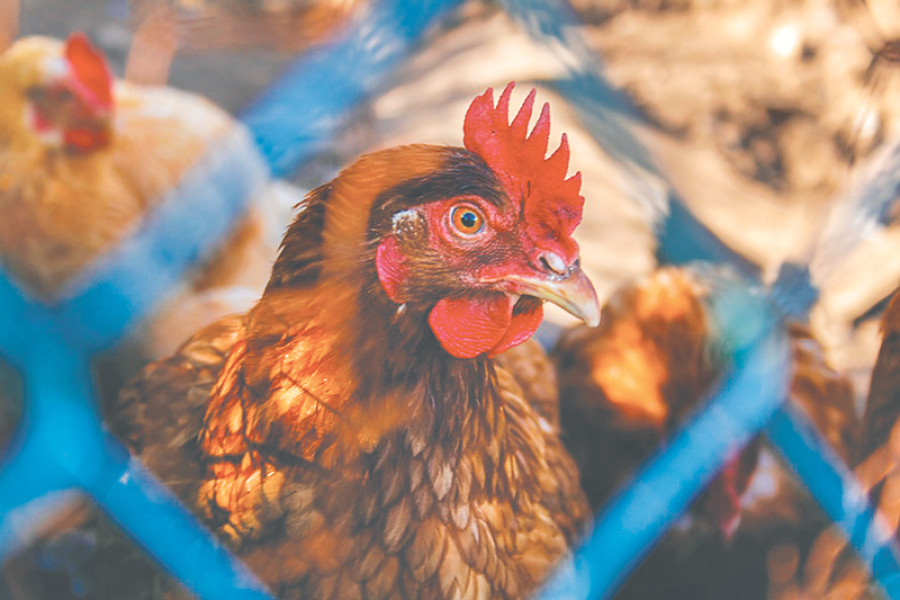Opinion
Count your chickens
Nepal’s poultry sector needs to tap into a swelling market for fast food in urban areas
Nanu Jha
Livestock is a key component of agriculture in Nepal making up 26.80 percent of the Agricultural Gross Domestic Product and nearly 11 percent of the National Gross Domestic Product. It has an annual growth rate of 4 percent, which is faster than that of food crops. Livestock farming plays an important role in reducing rural poverty, and it is one of the most attractive investment options for returning migrant workers.
Global meat production has more than doubled since the 1970s. The meat processing sectors, particularly the value-added segments, need to be promoted by encouraging domestic consumption and pushing exports. Changing food habits with a growing preference for fast food in industrialised and urbanised societies will greatly enhance demand for fresh, frozen and quality value-added products. Unlike the old generation, young people do not care about meat species. This means that there is a big scope for diversification of meat products.
Chicken market
Nepal’s per capita meat consumption is 9.4 kg which is low compared to other Asian countries. Its meat production reached 329,000 tonnes in fiscal 2012-13 with poultry making up 6 percent of the total. It is estimated that more than 70,000 people are employed in poultry production and marketing. The poultry sub-sector accounts for 8 percent of the Agricultural Gross Domestic Product. The poultry industry still has a relatively small base and is concentrated mainly close to urban areas. However, there is high potential for the development of poultry production and ancillary industries.
Chicken is becoming popular among consumers because it is white meat and a cheap source of animal protein. The poultry market in Nepal has swelled by 30 percent in the last five years. Chicken is one of the most popular domesticated fowls, and chicken meat and eggs are accepted diets. Day-old broiler chicks are supplied to distributors to sell to farmers who produce meat and eggs. When they become mature, they are shipped to the open market, restaurants and processing centres. Studies reveal that many actors such as farmers, traders, wholesalers and retailers play a major role in the whole process of value chain development of chicken meat production and marketing. Their share of the profits amounts to 12, 17, 20 and 21 percent respectively.
The chicken trade is dominated by traders and commission agents, and it needs to be transformed into an organised system for uniform sharing of the profits among all the actors. It is evident that the farmer’s share is relatively low among the actors in the value chain, and it could be an intervention point for a study. Nepal’s poultry industry is growing very fast, but in reality it has no option for product retrieval or reconditioning due to its perishable nature.
Existing hurdles
The constraints encountered in poultry production and marketing are poor economic condition of the farming community, lack of education and training about scientific poultry farming, uncertainty of outbreaks of poultry diseases (such as bird flu), expensive veterinary medicines and services, high cost of transportation and painful travel, lack of public awareness about quality meat products and increasing trend of live sales.
Another impediment to the development of the meat industry is the practice of slaughtering the birds in open places using unscientific and unhygienic methods. Due to lack of enforcement of the Slaughter House and Meat Inspection Act, it is difficult to maintain hygienic conditions in meat and meat products. If quality control tools such as good manufacturing practices (GMP) and Hazard Analysis Critical Control Point (HACCP) are adopted and applied by slaughter houses and meat processing plants, it will have a positive impact on improving the quality of meat and meat products. This will ultimately decrease risks to public health and thereby create a huge potential for business expansion across the country.
Going large-scale
The marketing of chicken meat, meat products and related inputs for the poultry industry is fully done through private channels based on personal contact and association. It is alleged that these channels are seldom transparent in terms of the quality, quantity and process of the products sold, leaving considerable scope for distortions and other forms of malpractices. The surge in the scope and size of the business is due mainly to the opening of big poultry farms, hatcheries and feed plants in Chitwan district, which is celebrated as the country’s poultry hub.
It is imperative that poultry enterprises be developed into large farms able to supply large quantities of chicken meat and meat products in the market. Going large-scale will permit mechanisation of poultry farming, slaughtering, processing, storing and transporting and bring down the cost of meat and meat products. Organised and mechanised production and marketing will increase efficiency in operations besides ensuring that quality and safety compliance in the food chain from production to consumption is maintained. National policymakers, poultry producers, meat processors, food technologists, veterinarians, national traders and even national decision makers have to work together for the establishment of a vibrant poultry industry in the country so that it can play a major role in increasing the National Gross Domestic Product in the coming years.
Jha is an agricultural economist and adjunct professor at the Himalayan College Agricultural Sciences and Technology




 10.12°C Kathmandu
10.12°C Kathmandu










